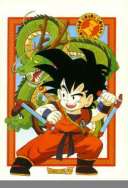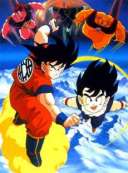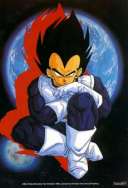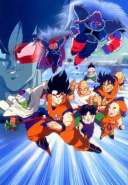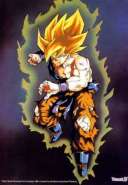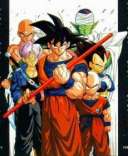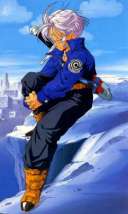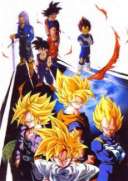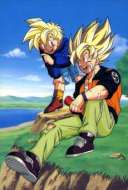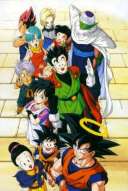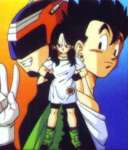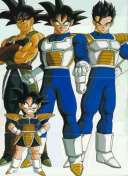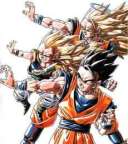

Dragon Ball Mirage
Home
Make Money
Sitemap
DB Intro
BookMark
E - Mail
Dragon Ball
DB Story
DB Storyline
DB Manga
DB Movies
DB Photo Album
Dragon Ball Z
DBZ Story
DBZ - TV
DBZ - TV Spec
DBZ Powerlevels!
DBZ Movies
SSaiyan Legend
DBZ Photo Album
Dragon Ball GT
DBGT Story
DBGT - TV
DBGT Characters
DBGT Perf FAQ
DBGT Photo Album
More...
Characters
Lyrics!
Midi Songs!
Books
Video Games!
Filez
Photo Album
Akira Toriyama!
Attacks
Reviews of Movies!
Guestbook
Read Guestbook!
Sign My
Guestbook!
Links
Links
Add Your Site
|
Originally, this file was designed solely for holding the reviews of the seven
"Complete Illustration" books. But, it's grown since then to contain
descriptions of as many of the other books as possible. There is no need to include the
various manga here, because they already have files of their own. Instead, I am using this
file to describe the "supporting" books -- Dragon Ball Z Perfect Files, museum
exhibit books, and The World books that complement some of the movies. Great thanks to Curtis Hoffman. This page was made by him. His site doesn't exist now, but he gave me authorization to have this page in my site! |
- Miscellaneous books on
Dragon Ball and Toriyama
- Dragon Ball Bouken (Adventure) Special
- Toriyama Akira The World
- Toriyama Akira The World Special
- Toriyama Akira The World Anime Special
- Jump Comics Selections
- Dragon Ball Seven-Book Set
- Dragon Ball GT: Perfect File
- Dragon Ball GT:
TV Special #1 Anime Comic
- Listing of Book Prices & Names
Brief Descriptions of Various Books on Toriyama and Dragon Ball
Return to the top of this file
The Complete Illustrations seven book set
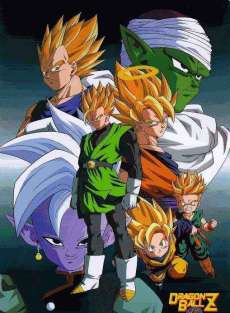 The Dragon Ball manga series has ended. The TV series wrapped up in
Sept., 1995. The last of the DBZ movies have already hit the theaters and is now on the
video rental shop shelves. The odds are that the Dragon Ball GT series will also have
ended by the time you return to read this file.
The Dragon Ball manga series has ended. The TV series wrapped up in
Sept., 1995. The last of the DBZ movies have already hit the theaters and is now on the
video rental shop shelves. The odds are that the Dragon Ball GT series will also have
ended by the time you return to read this file.
So, what's a poor Dragon Ball otaku to do?
Buy the Dragon Ball Daizenshuu books, of course. (Daizenshuu translates
roughly to "Big Complete Works." From this point on, I refer to all 7 books as
"The Complete Illustrations books".)
The DB: CI consists of full color illustrations from the last ten years of
the series. Inside the front cover of each book is a fold-out poster version of the cover
illustration. Throughout, there are thousands of photos from the TV series, manga, and
movies. There are more pencil sketches, and a HUGH amount of background detail on the
attacks, items, vehicles, and characters that western fans occasionally ask about. We even
get maps of the universe, and locations for Kame House, Karin Tower, Pilaf's Castle, and
the Tenkai-ichi Budoukai. At the end of books 1-6, there is also a series of interviews
with Toriyama himself.
However, the books are a bit pricey. In Japan, they cost 1500 to 1800 yen. To
ship them to the U.S., and then to make a profit on them, the import shops like Nikaku
Animart bump the prices up to about $35 - $50 per book.
This review file was created to help you decide which books you'd like to
get, and promote them for what they are -- One of the greatest resources to Dragonball
fans ever compiled.
Return to the top of this file
Book 1: Complete Illustrations
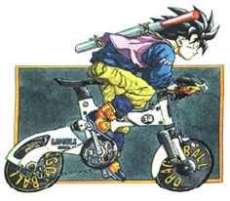 DB: CI consists of full-color illustrations from the last ten years of
the series. Inside the front cover is a fold-out poster version of the cover illustration.
On the other side of the poster is the pencil sketch used to create the last page of the
manga, where all of the characters say "Arigato", and Toriyama thanks his
readers for sticking with him. The next 12 sections are various splash pages, illos, and
special drawings collected by year. Starting in 1984, when Dragon Ball first appeared in
issue 51 of Shonen Jump, we get a wide variety of poses, gags, and artwork quality on up
to 1995 and the final installment in Shonen Jump issue 25.
DB: CI consists of full-color illustrations from the last ten years of
the series. Inside the front cover is a fold-out poster version of the cover illustration.
On the other side of the poster is the pencil sketch used to create the last page of the
manga, where all of the characters say "Arigato", and Toriyama thanks his
readers for sticking with him. The next 12 sections are various splash pages, illos, and
special drawings collected by year. Starting in 1984, when Dragon Ball first appeared in
issue 51 of Shonen Jump, we get a wide variety of poses, gags, and artwork quality on up
to 1995 and the final installment in Shonen Jump issue 25.
Each section starts with a "title" page; the title page contains
three or four pages from the manga, highlighting the storyline at that time, and
demonstrating part of the process of making manga (the artwork is finished, but all of the
word balloons are blank.) The illustrations include indications of which publications
they'd originally appeared in. Many are from Shonen Jump (WJ == Weekly Jump) of course,
but many more were created for V-Jump magazine, calendars, "Toriyama Akira: The
World" special, and a few other one-shot publications.
Chapter 13 consists of all the artwork from the covers of the collected manga
volumes. As can be expected, the artwork quality varies widely over the years. Some of the
covers look very, very cheap and rushed. Some of the others are highly detailed, and
impart a feeling of high-energy action. (As a bonus, the cover of volume #42 is included,
although 42 has not yet hit the shelves.) There is also a mural page showing all of the
cover spine artwork in sequence. And, from a casual viewing, it certainly appears that
Gokuu and Yajirobee are the only two characters to appear twice on the spines of the
books. To round things out, all of the inside coverflap "pictures of the artist"
are also included (Toriyama in his various incarnations, pictures of his baby son, and pet
dogs -- with a tribute to a deceased pet dog.)
Chapter 14 shows all of the Weekly Shonen Jump volume covers on which DB
characters appear on the cover (63: not many, given that there were over 520 issues of
Shonen Jump during this time.)
Chapter 15 is a 4-page interview with Toriyama (this will take me a long time
to read.) Chapter 16 wraps the book up with reprints of the volume covers, and special
one-shot illos.
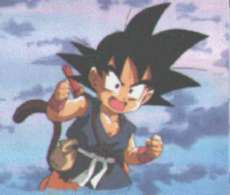 There are a few good gags that had appeared outside of the normal manga (in V-Jump,
Vejiita finally gets to beat Gokuu -- while the two of them are playing a Super Famicom
game; Kamesennin takes photos for an etchi calendar -- Buruma in the bath, Ranchi
undressing -- and gets his own picture in the calendar after Ranchi shoots him full of
holes.) There's also a fair bit of repetition, and cover artwork from each year gets run
again in Chapter 13.
There are a few good gags that had appeared outside of the normal manga (in V-Jump,
Vejiita finally gets to beat Gokuu -- while the two of them are playing a Super Famicom
game; Kamesennin takes photos for an etchi calendar -- Buruma in the bath, Ranchi
undressing -- and gets his own picture in the calendar after Ranchi shoots him full of
holes.) There's also a fair bit of repetition, and cover artwork from each year gets run
again in Chapter 13.
This is a good coffee table book, and can be fun to refer to off and on for
the next few years. It's priced at an average 1500 yen (average price for 200+ pages of
color artwork in Japan), and isn't all that bad a deal if you really like the series.
But, DB:CI is also pretty one-sided. It's just a collection of pictures, with
no commentary, and no real coherence. Anyone expecting something beyond what they already
own if they own the complete manga collection, will be very disappointed.
Therefore, it may be a good thing (depending on how you look at it) that
DB:CI is actually the first of 7 volumes. Then again, at about $35-$50 per book, the
entire collection will total well over $200. Only avid collectors will want all 7 books,
but casual fans, and anyone that likes good artwork, should be able to locate at least *1*
volume that appeals to them.
I like Complete Illustrations. It's obviously intended just to suck money out
of people, but I think it's a good value, anyway. I'm tempted to get all 7 books, and see
if I can summon Shenlon, but I'd have to find a way to get them mailed to America first (I
may be returning to the States before the last 3 books come out.) Instead, I may settle
for #3-5, and maybe pick up #7 later. If someone else manages to meet Shenlon, please get
an autographed photo for me...
Return to the top of this file
Book 2: Story Guide
Story Guide is another good coffee table book, and can be fun to refer to off and on for
the next few years. It's priced at 1800 yen and isn't all that bad a deal if you really
like the series. I consider Story Guide to be more satisfying than Complete Illustrations.
The artwork is very clean, the color pages are generally good (the older chapters suffer a
little from aging of the original artwork), and there's enough additional information
concerning the main cast that you can't really go wrong by getting this book.
Return to the top of this file
Book 3: TV Animation, Part 1
At
long last, I have finally gotten around to checking out this volume (as well as #5: TV
Animation, Part 2). One of the reasons that I held off so long was that I figured that I
really didn't need to buy a book that merely records what had shown up in the TV episodes.
After all, if I already have the tapes and the manga, why should I also get a book version
of the tapes?
But, I broke down and bought this book mainly to review it before selling it
to someone else. This said, I have to admit that there are a couple of good reasons for
adding Books 3 and 5 to your collection. First, they contain highlights of ALL the major
storylines, and are good for killing time looking at the nicely-made pictures. Second, the
authors went so far as to list the original TV episodes that had been made solely for
padding out the show (one-shot episodes that weren't based on the manga.)
As ever, the fold-out poster is a larger version of the cover art (Gokuu vs
Demon King Piccolo), with a collage of Gokuu's on the back side. The rest of the book
breaks up as follows:
Pages 16 - 119: Highlights of the episodes starting with the beginning of the
series, up to Gokuu's and Chi Chi's wedding. Interspersed throughout are descriptions of
the various opening and closing credit animations. These pages are all in color, and have
lots of comments and episode numbers.
Pages 120 - 121: Descriptions of the episodes created strictly for the TV
series and are not based on the manga.
Page 122: This page describes the Tsufuru-jin, and gives the background
needed to explain part of the goings-on for the Baby storyline in Dragonball GT.
Pages 123 - 136: Pencil sketches of all of the major good guys, showing them in
different clothing and stages of development.
Page 137: Opening and ending theme lyrics for "Romantiku Ageru Yo"
and "Maka Fushigi Adobenchaa!"
Pages 138 - 153: Pencil sketches of the villians and supporting characters.
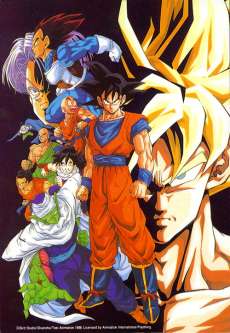 Page 154: Opening and ending theme lyrics for "Detekoi Tobikiri ZENKAI Powaa!"
and "CHA-LA, HEAD CHA-LA".
Page 154: Opening and ending theme lyrics for "Detekoi Tobikiri ZENKAI Powaa!"
and "CHA-LA, HEAD CHA-LA".
Pages 155 - 177: Highlights of various battles, up to and including the first
appearance and defeat of Prince Vejiita. For anyone that likes Radditz, there are several
photos of him here.
Page 178: Eye Catches (commercial break markers) for Dragon Ball and Dragon
Ball Z.
Pages 179 - 201: Highlights of the trip to Planet Namek, including the
conclusive battle against Team Ginyuu.
Pages 202 - 207: Interview with Toriyama.
Pages 208 - 233: Episode titles and summaries, including all 153 Dragon Ball
episodes, and the first 74 Dragon Ball Z episodes.
In
summary, this is a great book if you really like the TV series, and hate the manga. It's a
great resource for anyone trying to compile all of the episode titles, too. There's lots
and lots of pictures. Unfortunately, none of the text is in English, so as a reference,
this book is most useful to anyone that can read Japanese.
Curtis Bob-Briggs says "Check it out."
Return to the top of this file
Book 4: World Guide
This
is a quickie review because, of the 4 books currently out, World Guide has the most amount
of text, data, and sheer content, of the group.
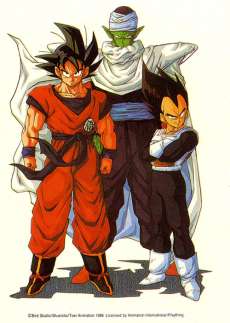 We start out with sketches of various characters, and
layouts detailing a variety of locations that have been featured in the manga and TV
series in the past. Then we get into "Racial Groups", "Field: Places
Besides the Earth", "Field: The Earth", "Grapple: Classification of
Attacks", "Grapple: Competition", and Technology.
We start out with sketches of various characters, and
layouts detailing a variety of locations that have been featured in the manga and TV
series in the past. Then we get into "Racial Groups", "Field: Places
Besides the Earth", "Field: The Earth", "Grapple: Classification of
Attacks", "Grapple: Competition", and Technology.
#4 is without a doubt, a must-have book for any fan of the series. It
includes a world map, showing where Kame House, Penguin Village, Mount Frypan, and Uranai
Baba's home are located (among other things.) There are names and faces for characters
that have only been identified by reference (eg. The Kaiou-shin that was the basis for Fat
Buu.) We also get a color reprint of the story where Gokuu chases Blue Shogun into Penguin
Village (and the appearance of the Dr. Slump cast.) Each Budokai is identified by number
(the last Budokai, with Uubu, is #28.) We have definitive proof that Buruma's father is
named "Briefs", her mother is named "Buruma's Mother", and the
announcer for the Budokai is named "the Budokai Announcer." Nearly every
vehicle, weapon, and magic item that was ever drawn in the manga, is also listed. Further,
if you wanted to know where the Gate to Heaven, Satan City, or the Namek Planet are
located, you can find that information here, along with pictures of the people/aliens/
villians that live in those places.
All of the DB coffee table books have clear artwork, lots of details,
readable (if you can read Japanese) text, and solid binding. Book #4 is 169 pages, for
1500 yen.
I consider this a good deal.
Return to the top of this file
Book 5: TV Animation, Part 2
Naturally,
Book 5 is a continuation of Book 3. The cover shows Freeza and young Gohan. The fold-out
poster is the same, with a group shot of Gohan, Gokuu, Young Trunks, Future Trunks, Goten,
Gotenks, Vejiita, Mystical Gohan, and Vejit on the back side (all in SSJ form.)
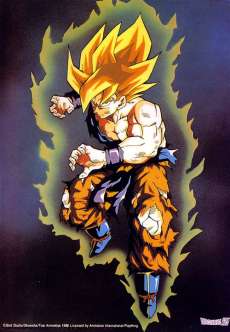 Pages 16 - 35: The battle against Freeza, and Gokuu's going SSJ.
Pages 16 - 35: The battle against Freeza, and Gokuu's going SSJ.
Pages 36 - 43, 52: Episode storylines that are original to the TV series,
including the appearance of Garlick, Jr. from one of the earlier DBZ movies.
Pages 44 - 101: Highlights from the appearance of Future Trunks to the first
battle against Stage 1 Cell. Then, including the battle against all of the androids, and
Perfect Cell. Ending with the appearance of Mr. Satan and the defeat of Cell.
Page 68: Copies of Toriyama's memos, showing sketches and notes for the
character designs to be used in the TV series.
Page 84: Stills from the opening credits used early on in DBZ.
Pages 102 - 103: A brief mention of the Future Trunks Special.
Pages 104 - 106: This section describes some of the differences between what
Toriyama drew in the original manga, and what actually appeared in the TV anime. (Example:
The way Fusion works between Goten and Trunks is much fancier and more colorful in the TV
series. And the relative heights of the various Z Fighters are not the same; Yamcha and
Kiririn became shorter in the anime.)
Pages 107 - 138: More pencil sketches for all of the characters that appear
from the Freeza battle, up to the appearance of Majin Buu.
Pages 139 - 145: Highlights of the Budoukai that occurred in the afterworld,
culminating in the battle between Gokuu and Paiku.
Pages 146 - 199: Gohan's first appearance as The Great Saiya-Man; Highlights
of various Bodoukai's; comments describing how side storylines link up with the main
plotlines; and the battle against Majin Buu.
Page 158: Stills from the opening credits where Gohan is the Great Saiya-man.
Page 170: Stills from the ending credits, where young Gohan rides Shenlon and
gets scared by Piccolo.
Page 186: Stills from the ending credits, showing all of the heroes, and
finishing with Gokuu wearing angel's wings, in the Other World.
 Pages 200 - 202: "The Variety of DB": These are shots from two videos made in
the past. One features a rare video game made for the Famicom game system. This equally
rare video shows the Z Fighters going up against a mad scientist named Dr. Lychee, and the
product of his Tsufuru science -- Hatchi-Hyakku (#800). The second video is a combination
of cel animation and computer graphics, and was used to advertise one of the games that
came out for the Super Famicom back in 1993.
Pages 200 - 202: "The Variety of DB": These are shots from two videos made in
the past. One features a rare video game made for the Famicom game system. This equally
rare video shows the Z Fighters going up against a mad scientist named Dr. Lychee, and the
product of his Tsufuru science -- Hatchi-Hyakku (#800). The second video is a combination
of cel animation and computer graphics, and was used to advertise one of the games that
came out for the Super Famicom back in 1993.
Page 203: Lyrics for "Boku-tachi wa Tenshi Datta", and "We
Gotta Power".
Pages 204 - 205: Pencil sketches showing a brief glimpse of True Buu, and the
character designs for Gokuu, Pan, and Trunks to be used in Dragon Ball GT.
Pages 206 - 211: Interview with Toriyama
Pages 212 - 233: Episode titles and summaries, from Dragon Ball Z episodes 75
to 268 (Mystical Gohan vs Piccolo/Buu).
In
summary, this is also a great book if you really like the TV series, and hate the manga.
It's a great resource for anyone trying to compile all of the episode titles, too. There's
lots and lots more pictures. Unfortunately, there's still no text in English, so as a
reference, this book is most useful to anyone that can read Japanese.
Curtis Bob-Briggs says "Check this one out, too."
Return to the top of this file
Book 6: Movies and TV Specials
It's taken a long time for me to get to this review, and I apologize.
Most of the information that appears in this book can also be found in other sources,
several of which has been incorporated into the Database already.
Of all of the Complete Illustrations books, #6 is the
least useful. It does have lots of nice pictures from the movies and TV specials, and it
compiles lists of all the characters, making it easier to find any given character from
any given movie. But, if you've seen the movies, then this book doesn't add much more to
one's understanding of what had happened.
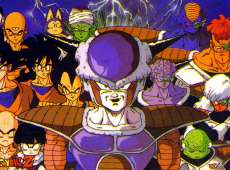 Actually, the main reasons for getting this book are: To
have pictures that you can scan into your computer; To see examples of all of the posters,
advertising items, and promotional goods that accompanied the movies; And to get a
complete listing of the staff and voice credits for all the films. The best thing about
this book is that the staff and voice credits are very complete. They are in Japanese
though, and if you don't know how to ready kanji, they won't be of much use to you.
Actually, the main reasons for getting this book are: To
have pictures that you can scan into your computer; To see examples of all of the posters,
advertising items, and promotional goods that accompanied the movies; And to get a
complete listing of the staff and voice credits for all the films. The best thing about
this book is that the staff and voice credits are very complete. They are in Japanese
though, and if you don't know how to ready kanji, they won't be of much use to you.
Each movie gets about 8 pages of coverage, with brief
descriptions of the storylines, pictures of the various characters, etc. The movies are
usually paired up, with the staff credits and posters appearing after every other movie
section. At the end, there is a short section for the Bardock and Future Trunks TV
specials. Then, the characters are grouped together by type (magical beings, robots,
etc.), and grouped by movie. Finally, there is another interview with Toriyama, and photos
showing him creating an autographed picture of Gokuu.
Book 6 is recommended to collectors that want to have
a copy of all of the Complete Illustration books. Note that summaries of the movies, and
character guides, can be found in the DB/DBZ movies guide. One
other interesting note is that the "Road to Greatest Strength" is mentioned
briefly in this book, although it hadn't premiered at the time #6 went to press.
Return to the top of this file
Book 7: Dragon Ball, Daijiten (Big Encyclopedia)
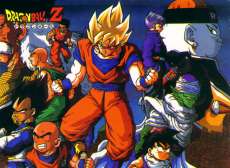 When reviewing books like this, especially when I don't know my audience,
it is very easy to become flippant and spend more time on trying to be clever, than in
actually concentrating on the content of the book itself. It becomes more of a problem
when I am faced with something like the Big Encyclopedia -- a book that is more text than
pictures, in a language that requires I spend a lot of effort to figure out what's going
on, and at a time when I feel very rushed with all of the projects that I'm trying to work
on.
When reviewing books like this, especially when I don't know my audience,
it is very easy to become flippant and spend more time on trying to be clever, than in
actually concentrating on the content of the book itself. It becomes more of a problem
when I am faced with something like the Big Encyclopedia -- a book that is more text than
pictures, in a language that requires I spend a lot of effort to figure out what's going
on, and at a time when I feel very rushed with all of the projects that I'm trying to work
on.
So, please bear with me when
I say that the Big Encyclopedia can either be the biggest waste of money of the seven
books, or can be the greatest treasure in your Dragon Ball collection.
As always, the Big
Encyclopedia is a colorful hardback book, with over 300 pages of information. Most of this
info is a rehash of what appears in the other six books, plus a preview of the (at the
time) newly started Dragon Ball GT series (and the preview material can now be found in
the below Perfect File.) The cover is a color version of the
group scene that appears at the end of the manga. The inside fold-out poster is a larger
version of the cover. On the reverse side of the poster is a massive collection of
character images, showing the progression of character designs through the various
storylines. Then, things get scholarly.
Chapter 1: Chronological Table of DB World
This section is a timeline for everything that happened in the manga, TV series, and
movies, or happens behind the scenes and is spelled out here for the first time. In the
background are color images from each storyline, used to illustrate these events. This timeline has been translated into English by
a Dutch fan. The final page is an explanation of the 4 timelines that Future Trunks
created when he used the Capsule Corp. time machine.
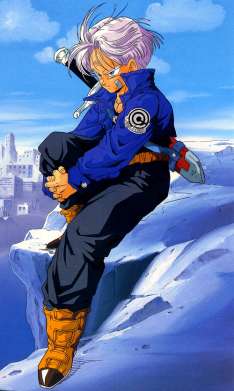 Chapter 2: World View for DB
Chapter 2: World View for DB
This chapter is largely text. It is broken up into sub-sections entitled
"Culture", "Society", and "Racial Groups". (According to the
pie chart, the DB world is 1% Half-breeds (Gohan), 7% monsters (Pilaf), 17% intelligent
animals (Oolong), and 75% humans (Kame-sennin). Planet Namek is 14% soldiers (Piccolo),
and 86% healers (Dende). This section of the encyclopedia uses pictures from the manga to
explain various elements of the universe, such as commerce, religion, and the construction
of different buildings.
Chapter 3: Human Racial Dictionary
This is a listing of ALL of the characters (including from the movies), and a short
description of who they are, where they are from, what race they are, and what they did in
the story. This is useful if you are trying to learn more about one of the more obscure
characters for a fan fic.
Chapter 4: Special Attack Dictionary
This section is exactly what the title says it is; an alphabetical listing of all of the
special attacks used in DB, and who used them. I haven't tried checking every single one
of these entries, but it certainly looks complete, including the gag attacks that Gotenks
pulled against Majin Buu.
Chapter 5: Rare Illustrations
Here, we have a few of the image drawings used to set the tone for Dragon Ball GT, plus a
few illustrations that appeared in other magazines, or advertising posters (includes one
of a pissed-looking Freeza holding a pen like he's a manga artist; gag images of Vejiita
bowling and rolling a gutter ball; Toriyama robot wearing the uniforms of the different
characters; and so on.) There's some good stuff in here.
Chapter 6: Item Dictionary
An alphabetical listing of all of the weapons, furniture, vehicles, and other objects that
appeared in the series. In the middle, a couple of pages are dedicated to the inventions
from Capsule Corp. and Red Ribbon. At the end, one page shows the influences for some of
the objects: The expanding bo, one fan, and Kintoun come from the Monkey King legends.
Yamcha's skimmer first appeared in Toriyama's Pink manga. The flyers that Mr. Satan and
Blue Shogun use are from Dr. Slump.
Chapter 7: Geographical Dictionary
An alphabetical listing of locations, when they appeared in the series, and maps for each
place described. Note that in the DBGT TV special, Gokuu's old house is supposed to be
located on Paozu mountain. Paozu Yama does not appear in the Geographical Dictionary.
Gokuu's old house is mentioned, but there's no names for the mountains in the area.
Chapter 8: Particulars Dictionary
This may be the biggest waste of ink in the entire book: an alphabetical listing of
sentences that the characters speak in the series. I guess that if you want to know who
said "Dr. Gero-sama", this dictionary would be a helpful resource. But, I myself
don't need something that can tell me when Gokuu said "Urenai Baba" instead of
"Uranai Baba".
Chapter 9: Pictorial Dictionary For DB Goods
This section is good if you like collecting DBZ paraphenalia, or like to see what DBZ
stuff looks like when it's sold in other countries. There's a timeline for when the manga,
collectors cards, games, and other toys were released for sale. If you collect the books,
there's a pictorial listing of the anime books, how-to game cheat books, and other
specials. (In a self-referential loop, the Complete Illustrations books also appear here.)
The movies have been released on tape and laser disc, and ordering information has its own
section. I've never seen any of the telephone cards myself, but there's been 14 of them as
shown on one page. Wuken is an avid CD collector, and he uses the CD dictionary to track
down the most hard-to-find CDs. Of course, there's couple of pages dedicated to the video
games, and more for the toys, key chains, and pen cases. I personally like seeing the
examples of DB manga printed in Korea, Taiwan, Hong Kong, Italy, France and Singapore.
Lastly, there's globe used to show where DB and DBZ are on TV (the entry for the U.S.
states that the series is just about to begin airing.)
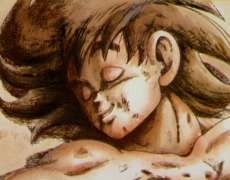 The Ten Years of Dragon Ball Splash Pages shows thumbnail images of the splash pages used
in the weekly manga series. This is followed by a 100-question quiz that had appeared in
1993, plus the answers. Finally, there is a reprinting of all of the cover flap comments
Toriyama had written for the 42 volumes of the manga.
The Ten Years of Dragon Ball Splash Pages shows thumbnail images of the splash pages used
in the weekly manga series. This is followed by a 100-question quiz that had appeared in
1993, plus the answers. Finally, there is a reprinting of all of the cover flap comments
Toriyama had written for the 42 volumes of the manga.
Thanks A Lot, by Akira Toriyama
The last 2 pages have a picture of adult Gokuu waving "goodbye", and a humble
Toriyama robot bowing. The text thanks everyone for everything they've done to make DB,
and the books, so successful.
In summary, this is a
useless book if you want pictures to scan, or reams of information that don't appear
anywhere else. Further, if you can't read Japanese or can only afford to buy one volume,
don't even bother thinking about getting this book (get books #4, #1 and #6 instead.)
On the other hand, if you are a hardcore DB fan, a collector, or a researcher
that can read Japanese, this is the FIRST book you should buy. All of the information you
could possibly want to look up has been laid out for you to locate quickly. There's lots
of good tidbits, and of course the pictures of the CDs and games will come in handy if you
want to buy them.
Completists will get all seven books anyway, and they'll be very happy with
the content of this book as it complements the rest of the collection. Personally, I'm
keeping my copy just to help me answer the questions that people keep asking me about the
series.
Return to the top of this file
Books Added to the Complete Illustrations Set Later On
Return to the top of this file
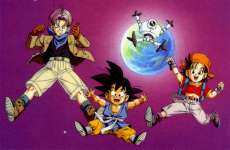 The
Perfect File is a Jump Anime Comics Jr. publication (ISBN4-8342-1524-5), which means that
it was created based purely on the anime (which is reasonable since there is no manga for
DBGT), and is aimed at children. Although the title implies that everything you want to
know about DBGT will be found within its covers, this book is far from complete. We can
expect to see one more "Perfect File", when the TV series ends (probably the
summer of 1997.)
The
Perfect File is a Jump Anime Comics Jr. publication (ISBN4-8342-1524-5), which means that
it was created based purely on the anime (which is reasonable since there is no manga for
DBGT), and is aimed at children. Although the title implies that everything you want to
know about DBGT will be found within its covers, this book is far from complete. We can
expect to see one more "Perfect File", when the TV series ends (probably the
summer of 1997.)
Return to the top of this file
Dragon Ball GT: Gokuu's Biography
The #4 Dragon Ball is the Proof of Courage
 This TV special had
aired in March of 1997, and was printed as a Jump Anime Comics (ISBN4-8342-1525-3) in
July. It is a color comic version of the TV special, and is aimed at children. It includes
a sheet of stickers, a color fold-out mini-poster, staff credits, and a little background
information. The background info covers Gokuu himself, and all of the character that
appear in the special.
This TV special had
aired in March of 1997, and was printed as a Jump Anime Comics (ISBN4-8342-1525-3) in
July. It is a color comic version of the TV special, and is aimed at children. It includes
a sheet of stickers, a color fold-out mini-poster, staff credits, and a little background
information. The background info covers Gokuu himself, and all of the character that
appear in the special.
The artwork is good, with very few bad cel
reproductions. The dialog seems to have been altered somewhat, and some of the scenes have
been shortened (when Manba scares off the wolves with her gun, the wolves run in panic for
about a minute, creating a good slapstick scene; the slapstick shots are missing from the
book.) But, this is still a good book, and well worth buying if you can't find a copy of
the TV anime.
I have put together a summary
of the TV special anime. In any case, I suggest that all fans of DBGT run over to the
Nikaku Animart web page, get their phone number, and order your copy of this book right
away. It's good stuff. (Unless some anime club wants me to buy 10+ copies of the book for
them...)
Return to the top of this file
Dragon Ball Books List

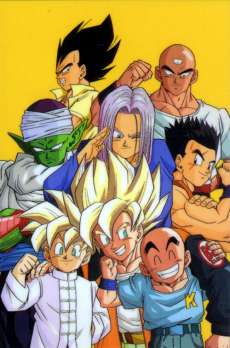 "Adventure History" is a 43-page presentation of the adventure side of the
manga, in words and pictures. The selection of panels to highlight each phase of the story
illustrates quite clearly that Toriyama's fight sequences are very high-energy.
"Adventure History" is a 43-page presentation of the adventure side of the
manga, in words and pictures. The selection of panels to highlight each phase of the story
illustrates quite clearly that Toriyama's fight sequences are very high-energy.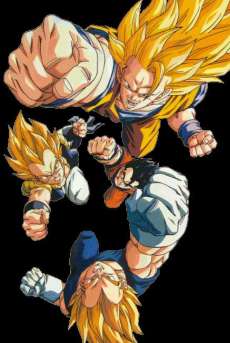 "All Battles" discusses each and every conflict between everyone that ever
appeared in the manga (187 by official count, including the bout between Gokuu and Uubu.)
"All Battles" discusses each and every conflict between everyone that ever
appeared in the manga (187 by official count, including the bout between Gokuu and Uubu.)